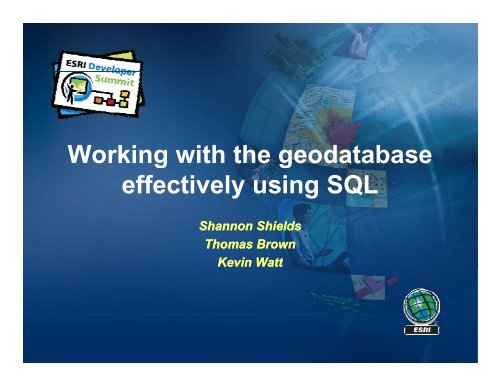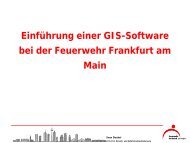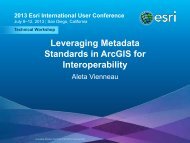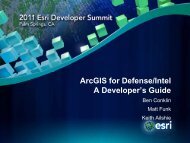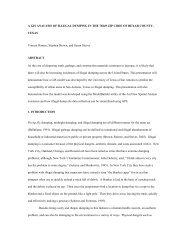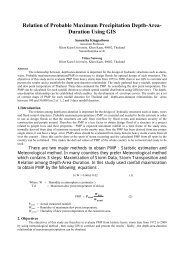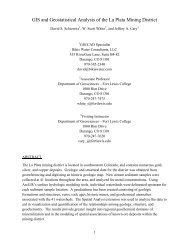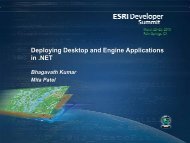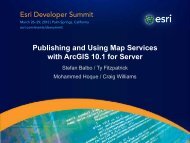Working with the geodatabase effectively using SQL - Esri
Working with the geodatabase effectively using SQL - Esri
Working with the geodatabase effectively using SQL - Esri
Create successful ePaper yourself
Turn your PDF publications into a flip-book with our unique Google optimized e-Paper software.
<strong>Working</strong> <strong>with</strong> <strong>the</strong> <strong>geodatabase</strong><br />
<strong>effectively</strong> <strong>using</strong> <strong>SQL</strong><br />
Shannon Shields<br />
Thomas Brown<br />
Kevin Watt
Today’s schedule<br />
• 75 minute session<br />
– 60 – 65 minute lecture<br />
– 10 – 15 minutes Q & A following <strong>the</strong> lecture<br />
• Cell phones p and pagers p g<br />
• Please complete <strong>the</strong> session survey – we take your feedback very<br />
seriously!
Why Use a Spatial Type?<br />
Efficiency y<br />
– Spatial data and methods are stored in <strong>the</strong> database<br />
– Spatial operations are encapsulated <strong>with</strong>in <strong>the</strong> type<br />
– Applications access native dbms type – no mapping layer<br />
Accessed <strong>using</strong> common API’s and <strong>SQL</strong><br />
– C, C++, C#, Java, OLEDB<br />
– <strong>SQL</strong> extensions enable spatial types and methods in DML and<br />
select statement syntax
What is a Spatial Type<br />
DBMS datatype and properties<br />
– Geometry type, coordinates, dimension, spatial reference<br />
Spatial Index<br />
– Access path for quick retrieval<br />
Operators and Functions<br />
– Constructors<br />
– Accessor<br />
– Relational<br />
– Geometry
Geodatabase geometry storage options<br />
<strong>SQL</strong> Server Oracle<br />
SDEBinary<br />
<strong>SQL</strong> SServer 2008<br />
GEOMETRY<br />
GEOGRAPHY<br />
SDEBinary<br />
SDELOB<br />
ST_GEOMETRY<br />
SDO SDO_GEOMETRY<br />
GEOMETRY<br />
DB2/Informix<br />
ST_GEOMETRY<br />
Postgre<strong>SQL</strong> g<br />
ST_GEOMETRY<br />
PostGIS<br />
GEOMETRY
st_geometry Properties<br />
• Geometry Type Name Type<br />
• Extent (MBR)<br />
------------- ----------<br />
ENTITY NUMBER(38)<br />
• Characteristics<br />
NUMPTS NUMBER(38)<br />
– Simple Simple, Empty, Empty Dimension<br />
MINX FLOAT(64) (6 )<br />
• Spatial Reference<br />
MINY FLOAT(64)<br />
• Coordinates<br />
MAXX FLOAT(64)<br />
MAXY FLOAT(64)<br />
AREA FLOAT(64)<br />
LEN FLOAT(64)<br />
SRID NUMBER(38)<br />
POINTS BLOB
Spatial Index<br />
Rtree or Grid, Grid-Tessellating<br />
Modeled as separate table or DBMS index<br />
AAssociated i t d to t geometry t type t and d operators t<br />
Enabled to <strong>the</strong> optimizer <strong>using</strong> statistics
Operators and Functions<br />
Constructors - Builds a new instance of <strong>the</strong> type yp<br />
– Can be overloaded<br />
ST_POINT (X, Y, SRID)<br />
ST_POINT ( (X, Y, Z, M, SRID) )<br />
ST_POINT (“X Y”, SRID)<br />
– Derived Subtypes can construct Supertype<br />
CREATE TABLE TABLE accidents (shape (shape ST ST_GEOMETRY);<br />
GEOMETRY);<br />
INSERT INTO accidents (ST_POINT(10,10,1));
Operators and Functions<br />
“A geometry’s internal representation is different from an<br />
applications external format to improve performance and storage<br />
efficiency”<br />
Accessor functions convert geometry data stored in internal format<br />
to an external application format
Operators and Functions<br />
Accessor<br />
– Well-Known Text<br />
INSERT INTO districts di t i t VALUES (ST (ST_POLYGON(‘polygon((10<br />
POLYGON(‘ l ((10<br />
10,50 10,50 50,10 50,10 10))’,1));<br />
SELECT ST ST_ASTEXT(A.SHAPE) ASTEXT(A SHAPE) FROM districts;<br />
ST_ASTEXT(SHAPE)<br />
---------------------------------------<br />
POLYGON ((10.0 ((10 0 10.0, 10 0 50 50.0 0 10 10.0, 0 50 50.0 0 50 50.0, 0 10 10.0 0<br />
50.0, 10.0 10.0))
Operators and Functions<br />
Accessor<br />
– Well-Known Binary<br />
SELECT ST_ASTEXT(ST_GEOMFROMWKB(ST_ASBINARY(SHAPE),1)) FROM districts<br />
ST_ ASTEXT(ST ( _ GEOMFROMWKB(ST ( _ ASBINARY(SHAPE),0))<br />
( ), ))<br />
---------------------------------------<br />
POLYGON ((10.0 10.0, 50.0 10.0, 50.0 50.0, 10.0<br />
50.0, , 10.0 10.0)) ))
Relational operators<br />
• Tests <strong>the</strong> spatial p relationship p between two geometry g y<br />
objects<br />
– Input (GEOMETRY_A, GEOMETRY_B)<br />
– Returns TRUE / 1 or FALSE / 0<br />
• Examples<br />
– ST_INTERSECTS<br />
– ST_TOUCHES<br />
– ST ST_CONTAINS<br />
CONTAINS
Relational operators<br />
• ST_ TOUCHES (Geometry ( y_ A, , Geometryy_ B) ) = 0 or 1<br />
Point / Line<br />
Point / Polygon<br />
Line / Line<br />
Line / Polygon<br />
Polygon / Polygon
Geometry operators<br />
• Builds a new geometry g y object j from one or more<br />
existing geometry objects<br />
– Input: (GEOMETRY_A, args…)<br />
– Returns: (GEOMETRY)<br />
• Examples<br />
– ST_BUFFER<br />
– ST_UNION<br />
– ST ST_DIFFERENCE<br />
DIFFERENCE
Geometry operators<br />
• ST_Union<br />
• ST_Difference<br />
(geom1 (geom1,geom2)<br />
geom2) (geom1 (geom1,geom2) geom2)
Using <strong>SQL</strong> <strong>with</strong> <strong>the</strong><br />
GGeodatabase d t b
Editing ArcGIS feature classes <strong>with</strong> <strong>SQL</strong><br />
• Edit simple p features onlyy<br />
– Points, lines, polygons (single or multipart)<br />
– Without <strong>geodatabase</strong> behavior<br />
• Not part of topology topology, geometric network<br />
• Editing g non-versioned feature classes<br />
– Applies directly to business table (no delta tables)<br />
• Editing versioned feature classes requires a defined<br />
workflow
Editing non-versioned feature classes<br />
• Requires q a unique q identifier (objectid) ( j ) when insertingg<br />
– Obtained from classes sequence or procedure<br />
• Can leverage DBMS functionality<br />
– Unique indexes, constraints, referential integrity, default<br />
values, , triggers gg
Obtaining unique row_id values<br />
• DBMS procedures for obtaining unique identifiers<br />
//Oracle<br />
<strong>SQL</strong>> SELECT registration_id FROM sde.table_registry<br />
WHERE owner = ‘TOMB’ AND table_name = ‘PARCELS’;<br />
<strong>SQL</strong>> SELECT sde.version_user_ddl.next_row_id(‘TOMB’, 114)<br />
FROM dual;<br />
//<strong>SQL</strong>*Server<br />
SELECT registration_id FROM sde.sde_table_registry<br />
WHERE owner = ‘TOMB’ AND table_name = ‘PARCELS’<br />
DECLARE @id AS INTEGER<br />
DECLARE @num_ids AS INTEGER<br />
exec sde.i114_get_ids 2, 1, @id OUTPUT, @num_ids OUTPUT
Editing Versioned feature classes<br />
• Use <strong>SQL</strong> to access multiversioned views<br />
– Ability to modify geometry when stored as a spatial type<br />
– Documentation is located <strong>with</strong>in ArcGIS Desktop Help<br />
• Recommended workflow<br />
– Create multiversioned views<br />
– Create a new version<br />
– Perform edits <strong>with</strong>in <strong>the</strong> new version<br />
– Use ArcMap to reconcile/post to its parent version
<strong>Working</strong> <strong>with</strong> multiversioned views<br />
• For non-ESRI applications which require <strong>SQL</strong> access to versioned<br />
tables<br />
– Ability to access any version<br />
– View derives a result set based on a version query<br />
– Procedures provided <strong>with</strong> SDE installation<br />
• SDE administration command for creating <strong>the</strong> view<br />
sdetable –o create_mv_view –T -t <br />
[ [-i i < ] i >] [ [-s < ] >] [ [-D D ]<br />
–u [-p ] [-N] [-q]<br />
sdetable –o create_mv_view –T parcels_mv –t parcels –i 5151<br />
–s alex l –u ttomb b -NN
<strong>Working</strong> <strong>with</strong> multiversioned views<br />
• DBMS procedure for setting <strong>the</strong> version for <strong>the</strong> view to reference<br />
//Oracle<br />
<strong>SQL</strong> <strong>SQL</strong>> exec sde.version_util.set_current_version d i til t t i (‘tomb.PROPOSED_SUBDIVISION’);<br />
(‘t b PROPOSED SUBDIVISION’)<br />
<strong>SQL</strong>> SELECT owner, parcel_id FROM parcel_mv<br />
WHERE st_envintersects(shape, 5,5,10,10) = 1;<br />
//<strong>SQL</strong>*Server<br />
exec sde.set_current_version (‘tomb.PROPOSED_SUBDIVISION’)<br />
or<br />
exec dbo.set dbo.set_current_version current version ( (‘tomb.PROPOSED tomb.PROPOSED_SUBDIVISION SUBDIVISION’) )<br />
//DB2<br />
call setcurrentversion (‘tomb.PROPOSED_SUBDIVISION’)
<strong>Working</strong> <strong>with</strong> multiversioned views<br />
• DBMS procedures for editing a versioned <strong>geodatabase</strong> and<br />
multiversioned views<br />
//Oracle<br />
<strong>SQL</strong>> exec sde.version_user_ddl.edit_version (‘tomb.PROPOSED_SUBDIVISION’, 1);<br />
<strong>SQL</strong>> UPDATE parcel_mv SET owner = ‘Ethan Thomas’<br />
WHERE parcel_id = ‘322-2002-001’ AND st_intersects(shape,st_geom) = 1;<br />
<strong>SQL</strong>> COMMIT;<br />
<strong>SQL</strong>> exec sde.version_user_ddl.edit_version (‘tomb.PROPOSED_SUBDIVISION’, 2);<br />
//<strong>SQL</strong>*Server<br />
//<strong>SQL</strong> Server<br />
exec sde.edit_version (‘tomb.PROPOSED_SUBDIVISION’, 1)<br />
exec dbo.edit_version (‘tomb.PROPOSED_SUBDIVISION’, 2)
Rules when working <strong>with</strong> multiversioned views<br />
• Do not update <strong>the</strong> objectid (row_id) value<br />
• Do not edit archive enabled classes in <strong>the</strong> DEFAULT version<br />
– See Knowledge Base article: 35645<br />
• Do not modify geometries for classes participating in topologies<br />
or geometric networks<br />
– Will not create dirty areas or be validated<br />
– Will not maintain connectivity in <strong>the</strong> logical network<br />
• DDo not t update d t attributes tt ib t which hi h define d fi <strong>geodatabase</strong> d t b bbehavior h i<br />
– Enabled/Disabled attributes<br />
– Ancillary attributes<br />
– Weight attributes<br />
– Subtypes
Spatial views<br />
• Spatial views are stored as any o<strong>the</strong>r view -- in <strong>the</strong> database<br />
• Views can be created <strong>with</strong> sdetable or created in <strong>the</strong> database and<br />
registered <strong>with</strong> ArcGIS
Registration<br />
• Registration informs <strong>the</strong> <strong>geodatabase</strong> of tables or views<br />
containing spatial attributes created outside ArcGIS<br />
• Registration writes information about <strong>the</strong>se tables and <strong>the</strong> spatial<br />
attribute into <strong>the</strong> <strong>geodatabase</strong> system tables so ArcGIS can<br />
access <strong>the</strong>m properly<br />
– Description p of <strong>the</strong> table’s attributes<br />
– Type of features in <strong>the</strong> spatial attribute<br />
– Spatial reference information
Using ArcObjects<br />
• Nothing gp prevents <strong>the</strong> application pp developer p from<br />
consuming relational operators via ArcObjects<br />
//Oracle, // , st_ggeometry y<br />
pQueryDef = pFeatureWorkspace.CreateQueryDef();<br />
pQueryDef.Tables = “tb.parcels”, “tb.neighborhoods”;<br />
pQueryDef.SubFields = “parcels.objectid";<br />
pQueryDef.WhereClause Q D f Wh Cl =<br />
“sde.st_intersects(parcels.shape, neighborhoods.shape) = 1”;<br />
pCursor = pQueryDef.Evaluate();<br />
IRow pRow = pCursor.NextRow();<br />
iint t pCnt C t = 00;<br />
if (pRow != null)<br />
{<br />
pCnt = pCnt + 1;<br />
MMarshal.ReleaseComObject(pRow); h l R l C Obj t( R )<br />
}
<strong>Working</strong> <strong>with</strong> Postgre<strong>SQL</strong><br />
Spatial Types<br />
ESRI Developer Summit 2008 28
What is Postgre<strong>SQL</strong>?<br />
– Open Source RDBMS<br />
– Conforms to <strong>SQL</strong> 92/99 standards<br />
– Includes complex database features<br />
(Inheritance, stored procedures, UDT, views, extensible index<br />
framework, etc.)<br />
ArcGIS Server Enterprise 9.3 includes<br />
– ArcSde for Postgre<strong>SQL</strong> (installs Postgre<strong>SQL</strong> rdbms)<br />
– Support for <strong>SQL</strong> Spatial types
Spatial types in Postgre<strong>SQL</strong><br />
• Two spatial types<br />
– ST_GEOMETRY (ESRI)<br />
– GEOMETRY (Open source project - PostGIS PostGIS)<br />
• Both are OGC/ISO compliant<br />
– support standard constructor, accessor, analytical functions<br />
• Full <strong>geodatabase</strong> functionality supported on both spatial types<br />
– geometric networks, topology, versioning, archiving, replication etc.<br />
• Both types provide spatial index functionality
What is different between <strong>the</strong> two spatial types?<br />
ST_GEOMETRY<br />
GEOMETRY<br />
• RResides id under d ‘sde’ ‘ d ’ schema h • Resides under ‘public’ schema<br />
• Consistent implementation<br />
across databases (Oracle,<br />
Informix, DB2, Postgre<strong>SQL</strong>)<br />
• Supports parametric curves,<br />
surfaces, and point-id<br />
• Stored as compressed shape<br />
• Only available in Postgre<strong>SQL</strong><br />
• Not supported<br />
• Stored as Well Known Binary<br />
Developer Summit 2008 31
st_geometry<br />
• Default <strong>geodatabase</strong> spatial type<br />
– GEOMETRY_STORAGE parameter value defines <strong>the</strong> storage type<br />
– ‘ST_GEOMETRY’ or ‘PG_GEOMETRY’<br />
• Superclass st_geometry implemented as a UDT<br />
• Subtype (st_point, st_linestring, st_polygon, st_multipoint…) created as<br />
a domain type<br />
CREATE DOMAIN sde.st_point AS sde.st_geometry<br />
CONSTRAINT st_point_check<br />
CHECK ((point_constraint(VALUE) = true));<br />
• Spatial Index<br />
– Uses GiST indexing framework<br />
– Implements Rtree indexing strategy
Creating data <strong>with</strong> st_geometry<br />
\\ Create table <strong>with</strong> st_geometry column<br />
CREATE TABLE gis.blocks_st (objectid INTEGER NOT NULL, block<br />
VARCHAR(24) VARCHAR(24), shape st st_geometry);<br />
geometry);<br />
\\ Assign ownership<br />
alter table gis.blocks_st owner to gis;<br />
\\ Create spatial index<br />
CREATE INDEX blockssp_idx ON gis.blocks_st USING gist(shape<br />
st st_geometry_ops);<br />
geometry ops);<br />
\\ Register <strong>with</strong> SRID<br />
SELECT<br />
sde.st_register_spatial_column(‘mydb','gis','blocks_st',<br />
'shape',1);<br />
\\ Insert Data<br />
INSERT INTO gis.blocks_st VALUES (1,‘block',<br />
st_geometry('polygon((52 28,58 28,58 23,52 23,52 28))'1));<br />
Developer Summit 2008 33
Creating data <strong>with</strong> Geometry<br />
\\ Create table<br />
CREATE TABLE gis.blocks_pg (objectid INTEGER NOT<br />
NULL NULL,block block VARCHAR(24));<br />
\\ Add spatial column<br />
SELECT public.Addgeometrycolumn (‘gis’, ’blocks_pg’,<br />
’geom’, -1, ’POLYGON’, 2);<br />
\\ Assign ownership<br />
alter table gis.blocks gis.blocks_pg pg owner to gis<br />
\\ Create spatial index<br />
CREATE INDEX blockssp_idx ON blocks_st USING gist(geom<br />
gist_geometry_ops<br />
i t t<br />
\\ Insert data<br />
INSERT INTO gis.blocks g _pg pg ( (ID, , g geom, , block) )<br />
VALUES (1,GeomFromText('POLYGON((52 28,58 28,58 23,52 23,<br />
52 28)',2227),'block');<br />
Developer Summit 2008 34
<strong>Working</strong> <strong>with</strong> spatial data in Postgre<strong>SQL</strong><br />
• Register <strong>with</strong> Geodatabase<br />
// Geodatabase<br />
sdelayer -o register -l blocks_st,shape -e a<br />
-C objectid objectid,SDE SDE -t ST ST_GEOMETRY GEOMETRY -i esri esri_sde sde<br />
-D mydb -u gis -p gis<br />
// Geodatabase<br />
sdelayer -o o register -l l blocks blocks_pg,geom pg geom -e e a<br />
-C objectid,SDE -t PG_GEOMETRY -i esri_sde<br />
-D mydb -u gis -p gis
<strong>Working</strong> <strong>with</strong> spatial data in Postgre<strong>SQL</strong><br />
• Querying spatial attributes<br />
SSELECT C st.objectid, bj id st_astext(shape) ( h )<br />
FROM map.blocks_st st<br />
WHERE st_astext(sde.st_intersection<br />
(sde.st_geometry('polygon ((52 28,58 28,58 23,<br />
52 23,52 8))’ ,1),st.shape))::text<br />
NOT LIKE '%EMPTY%';<br />
OBJECTID SHAPE_WKT<br />
-------- -------------------------------------------<br />
1 POLYGON ((2217028.84 399516.70, 2217028.84<br />
399507.82, 2217039.12 399507.82, 2217039.12<br />
399516.70, 2217028.84 399516.70))<br />
Developer Summit 2007 36
<strong>Working</strong> <strong>with</strong> <strong>SQL</strong> Server 2008<br />
Spatial Types<br />
ESRI Developer Summit 2008 37
Spatial data in <strong>SQL</strong> Server 2008<br />
• Microsoft introduces two new Spatial data types<br />
GEOMETRY<br />
– XY coordinates on a plane<br />
– Supports geographic and projected coordinate systems<br />
– OGC compliant<br />
GEOGRAPHY<br />
– Latitude, longitude coordinates on an ellipsoid<br />
– Supports only geographic coordinate system<br />
Spatial reference must match <strong>SQL</strong> Server-supported EPSG<br />
codes defined in sys.spatial_reference_systems<br />
sys spatial reference systems<br />
• Implemented as .NET CLR (UDT) data type<br />
• Available in all 2008 editions except Compact edition<br />
Developer Summit 2008 38
Comparing Geometry and Geography types<br />
ASPECT GEOMETRY GEOGRAPHY<br />
Line interpolation Cartesian Great Circle<br />
Spatial Domain Defined by coordinate<br />
system<br />
Units from calculations Defined by coordinate<br />
system y – same as data<br />
units<br />
Supported coordinate<br />
systems<br />
Any SRID<br />
SRID has no inherent<br />
meaning, but is required<br />
for comparisons<br />
Sphere (Earth)<br />
Defined by coordinate<br />
system y – meters or feet<br />
Defined in<br />
sys.spatial_reference_<br />
systems table
<strong>SQL</strong> Server spatial index<br />
• 4-level tesselated grid hierarchy<br />
• Adjustable<br />
• Created by ArcGIS <strong>using</strong> feature class extent and<br />
dbtune parameters B_MS_SPINDEX and<br />
A_MS_SPINDEX<br />
Developer Summit 2008 40
Spatial index usage<br />
• <strong>SQL</strong> Server Query Optimizer determines whe<strong>the</strong>r<br />
spatial index is used<br />
– Improvements to optimizer <strong>with</strong> regard to spatial indexes<br />
announced for <strong>SQL</strong> Server 2008 SP1<br />
– Behavior of optimizer is still evolving<br />
– CCurrently tl diffi difficult lt to t make k recommendations d ti on spatial ti l index i d<br />
settings for different mixes of features<br />
• Sp_help_spatial_geometry/geography_index<br />
– Describes efficiency y of spatial p index for a given g filter shape p
Creating a <strong>SQL</strong> Server spatial index<br />
GEOGRAPHY TYPE<br />
CREATE SPATIAL INDEX spidx_geography<br />
ON world world_rivers rivers (geography (geography_col) col)<br />
USING GEOGRAPHY_GRID WITH (<br />
GRIDS = (LOW, LOW, MEDIUM, HIGH),<br />
CELLS CELLS_PER_OBJECT PER OBJECT = 64);<br />
GEOMETRY TYPE<br />
CREATE SPATIAL INDEX spidx spidx_geometry geometry<br />
ON parcels (geometry_col)<br />
USING GEOMETRY_GRID WITH (<br />
BOUNDING BOUNDING_BOX BOX = (0 (0, 00, 500 500, 200) 200),<br />
GRIDS = (MEDIUM, MEDIUM, MEDIUM, HIGH),<br />
CELLS_PER_OBJECT = 64);
<strong>SQL</strong> Server spatial queries<br />
-- Select all rivers that intersect Sonora<br />
SELECT r.name, r.shape.STLength()/1000 length_km FROM gdb.rivers r WHERE<br />
(SELECT s.shape FROM gdb.states s<br />
WHERE name = 'Sonora').STIntersects(r.Shape) = 1
Registering existing <strong>SQL</strong> Server tables <strong>with</strong> spatial<br />
columns<br />
• Registration: g storing g metadata about a tables so that<br />
ArcGIS knows <strong>the</strong> characteristics of <strong>the</strong> spatial<br />
attribute<br />
• Tables created <strong>with</strong> ArcGIS are already registered<br />
• Tables created <strong>with</strong> <strong>SQL</strong> Server or o<strong>the</strong>r tools must be<br />
manually y registered g<br />
sdelayer –o o register –l l blocks blocks,geog_col geog col –e e an+c –t t GEOGRAPHY<br />
–C objectid,sde –G 4326 –k GEOGRAPHY –P HIGH …<br />
Developer Summit 2008 44
Registration considerations<br />
• Registration g does not add a spatial p index or calculate a<br />
layer extent<br />
– Manually create your own index, or move layer in and out of<br />
load_only_io mode<br />
– Use sdelayer –o alter to calculate an extent<br />
• Registration does not check for valid geometries<br />
– Use STIsValid and MakeValid methods<br />
• Registration pre-requisites<br />
pre requisites<br />
– Single spatial column<br />
– Single entity type (point, line or polygon)<br />
– Si Single l coordinate di t reference f (SRID)
Registration and SRID<br />
• What is an SRID<br />
– ArcGIS: complete spatial reference (sde_spatial_references)<br />
• offsets, scale, units, cluster tolerance, coordinate system<br />
– Geography: coordinate system (sys.spatial_reference_systems)<br />
– Geometry: Arbitrary but required<br />
• Registering a table <strong>with</strong> existing features<br />
Existing <strong>SQL</strong> Server SRID is recorded in<br />
– Existing <strong>SQL</strong> Server SRID is recorded in<br />
sde_spatial_references (auth_srid)
Registering empty tables<br />
• ArcGIS sets <strong>SQL</strong> Server SRID<br />
– Geography: epsg code from sys.spatial_reference_systems<br />
– Geometry: epsg code from sys.spatial_reference_systems (if any)<br />
OR ArcGIS SRID<br />
• Workflow: Geography<br />
– Provide –G <strong>with</strong> valid coordinate reference<br />
– If no –G specified default is 4326 WGS84<br />
• Workflow: Geometry<br />
– Using <strong>SQL</strong>, insert single feature <strong>with</strong> desired SRID<br />
– Provide –G <strong>with</strong> valid coordinate reference<br />
– Delete dummy feature after registration<br />
• Alternatively, use –R option to use existing ArcGIS spatial<br />
reference
<strong>Working</strong> <strong>with</strong> Oracle<br />
st_geometry<br />
ESRI Developer Summit 2008 48
Knowledge Base<br />
Many articles available
Migration options for moving to a spatial type<br />
• ArcGIS 9.3 default storage <strong>with</strong> Oracle is st_geometry<br />
• Geoprocessing tool for converting non-versioned and versioned<br />
feature classes in-line
Oracle Export/Import <strong>with</strong> st_geometry and spatial<br />
indexes<br />
• ArcGIS 9.3<br />
– Spatial index no longer exported, but created during <strong>the</strong> import<br />
SSee Knowledge K l d Base B article: ti l 34342
Oracle partitioning and st_geometry<br />
• Supports range partitioning <strong>with</strong> global or local spatial indexes<br />
• ArcGIS 99.3 3 provides fur<strong>the</strong>r support for creating partitioned spatial<br />
indexes via <strong>the</strong> dbtune<br />
– Future development work for providing partitioned statistics<br />
See Knowledge Base article: 34119
Index scans or Full table scans<br />
– Clustering<br />
• Represents how well <strong>the</strong> table is clustered based on <strong>the</strong> indexed<br />
attribute<br />
• For <strong>the</strong> rows where owner =‘BROWN’ BROWN<br />
– Are <strong>the</strong> rows stored in <strong>the</strong> same data block<br />
– Or are <strong>the</strong> rows dispersed among many data blocks<br />
• When clustered, less i/o is required to retrieve <strong>the</strong> row
Example: Clustered table<br />
Table Extent<br />
Rows<br />
149<br />
151<br />
152<br />
Key Column Values<br />
Index<br />
149<br />
151<br />
152<br />
Leaf Block<br />
Data Block
Example: Non-clustered table<br />
Table Extent<br />
Row 151 Row 152<br />
Key Column Values<br />
Index<br />
149<br />
151<br />
152<br />
Index<br />
Leaf Block<br />
Row 149<br />
Data Block
Clustering applies to spatial attributes<br />
• Very important when <strong>the</strong> majority of queries are spatial<br />
– Every map display…<br />
• SDE administration command for non-versioned layers y<br />
sdeexport –o create –t -f <br />
[-i ] [-s ] [-D ]<br />
–u [-p ] [-N] [-q]<br />
• Able to use <strong>SQL</strong> to spatially cluster data<br />
See Knowledge Base article: 32423<br />
See Knowledge Base article: 33341
st_geometry synonyms<br />
• Best practice when developing <strong>SQL</strong> applications is to fully qualify<br />
all objects<br />
SELECT owner, sde.st sde.st_astext(shape) astext(shape) AS GEOMETRY<br />
FROM tb.parcles<br />
WHERE sde.st_envintersects(shape,10,10,20,20) = 1<br />
See Knowledge Base article: 34004<br />
See Knowledge Base article: 34328
st_geometry synonyms<br />
Oracle 11g and 10.2.0.4 prohibit <strong>the</strong> creation of public synonyms<br />
named st_* (st_geometry, st_contains, st_relate…)<br />
• ArcGIS 9.3 no longer g creates public p synonyms y y for types yp and<br />
operators for new installations<br />
– Application developers must fully qualify all references to types and<br />
operators<br />
• Upgrading from an ArcGIS 9.2 instance will not drop existing<br />
public synonyms<br />
– Application developers can continue to leverage existing public<br />
synonyms
Power of aggregation<br />
• New functionality <strong>with</strong> ArcGIS 9.3 for Oracle<br />
– st_union_all<br />
– st_intersection_all<br />
– st_convexhull_all<br />
_ _<br />
SELECT owner, sde.st_astext(<br />
sde.st_union_all(shape)) AS GEOMETRY<br />
FROM tb.centerlines<br />
WHERE street_name = ‘CENTER ST’;<br />
INSERT INTO lightning_areas lightning areas SELECT oid oid.nextval, nextval<br />
sde.st_convexhull_all(shape)<br />
FROM lightning_strikes<br />
WHERE strike_date = TO_ DATE(’03-15-08’,’MM-DD-YYYY');<br />
( , );
Indexing st_geometry properties<br />
• Area and length are properties of <strong>the</strong> st_geometry type can be<br />
queried directly<br />
– Verses deriving <strong>the</strong> property from <strong>the</strong> geometry directly via an<br />
operator<br />
SELECT name, species, a.shape.area AS AREA<br />
FROM forrest_stands a<br />
WHERE a.shape.area > 100000<br />
// Create <strong>the</strong> index…<br />
CREATE INDEX forrest_area<br />
ON forrest_stands (shape.area);
<strong>Working</strong> <strong>with</strong> relational<br />
operators<br />
t
Relational operators<br />
Difference between a.shape and b.shape<br />
Is it… st_contains (a.shape, b.shape)<br />
or<br />
st_contains (b.shape, a.shape)<br />
• Review <strong>the</strong> operator definition<br />
• Check join aliases (a table, b table)<br />
• Impacts <strong>the</strong> optimizer and access path<br />
• Test and know <strong>the</strong> results!
st_distance<br />
• Is NOT a relational operator p which leverages g <strong>the</strong> spatial p<br />
index<br />
• It is a function for computing distance between two<br />
objects<br />
Question:<br />
“ Locate all wells <strong>with</strong>in 5 miles from a given g location<br />
and order <strong>the</strong> results based on <strong>the</strong> distance… ”
st_distance<br />
• Inefficient approach… pp<br />
SELECT name, volume, st_distance(shape,<br />
st_point(125,350,3)) AS DISTANCE<br />
FROM wells<br />
WHERE st_distance(shape,st_point(125,350,3)) < 5<br />
ORDER BY distance<br />
– Results in a full table scan of wells, calculating <strong>the</strong> distance<br />
, g<br />
between each well and <strong>the</strong> input geometry to detect if <strong>the</strong><br />
distance is less than 5 miles
st_distance<br />
• Efficient approach… pp<br />
SELECT name, volume, st_distance(shape,<br />
st st_point(125,350,3)) point(125 350 3)) AS DISTANCE<br />
FROM wells<br />
WHERE st_intersects(shape,<br />
st st_buffer(st_point(125,350,3),5)) buffer(st point(125 350 3) 5)) = 1<br />
ORDER BY distance
How st_intersects and st_buffer interacts<br />
• A very y common access ppath for finding g relationships p<br />
between objects is to buffer an input shape and use <strong>the</strong><br />
output geometry as input to st_intersects<br />
Question:<br />
“ I want to discover all single family residential parcels<br />
<strong>with</strong> an appraisal value less than 125K and are <strong>with</strong>in a ½<br />
mile distance from a bus stop… ”
How st_intersects and st_buffer interacts<br />
• Efficient access path p (but ( still expensive…)<br />
p )<br />
SELECT a.address, a.pin, st_distance(a.shape,b.shape)<br />
FROM parcels aa, busstops b<br />
WHERE a.appraisal < 125000 AND a.zoning = ‘SFR’<br />
AND st_intersects(b.shape,<br />
st st_buffer(a.shape,2640)) buffer(a shape 2640)) = 1<br />
– Initial access path is via a composite attribute index on appraisal and<br />
zoning returning each parcel’s shape as input to st_buffer, which is<br />
than input to st_intersects and busstops’ spatial index<br />
– For each candidate two spatial operations
How are geometries passed to operators…<br />
• Step 1: Access path via <strong>the</strong> parcel’s composite index<br />
for <strong>the</strong> predicate filter to obtain <strong>the</strong> parcel geometry<br />
WHERE a.appraisal < 125000 AND a.zoning = ‘SFR’<br />
Index Parcel’s table<br />
ROWID APPRAISAL ZONING<br />
AADA… 45000 SFR<br />
AABA… 52000 MPR<br />
AABA… 59000 SFR<br />
AACD… 79000 SFR<br />
AACD… 79000 COM<br />
AABC… 94000 SFR<br />
AABC… 105000 COM<br />
AABC… 122000 SFR<br />
AABC… 130000 SFR<br />
ROWID OBJECTID … SHAPE<br />
AADA… 136072<br />
AABA… 852018<br />
AACD… 854211<br />
AABC… 29375<br />
AABC… 482190
How are geometries passed to operators…<br />
• Step 2: Each geometry is passed individually to <strong>the</strong><br />
st st_buffer buffer operator<br />
st_buffer(a.shape,2640)<br />
Parcel’s table Buffered Shape<br />
ROWID OBJECTID … SHAPE<br />
AADA… 136072<br />
AABA… 852018<br />
AACD AACD… 854211<br />
AABC… 29375<br />
AABC… 482190
How are geometries passed to operators…<br />
• Step 3: The buffered shape becomes <strong>the</strong> input to<br />
st st_intersects intersects<br />
AND st_intersects(b.shape,<br />
st st_buffer(a.shape,2640)) buffer(a.shape,2640)) = 1<br />
– Using g <strong>the</strong> buffered shape’s envelope as <strong>the</strong> primary y filter to search<br />
busstop’s spatial index
How are geometries passed to operators…<br />
GY<br />
• Step 4: The envelope is applied to <strong>the</strong> spatial index to<br />
detect all intersecting busstops<br />
97<br />
96<br />
95<br />
94<br />
AABA…<br />
AABC…<br />
AADA…<br />
AACD…<br />
60 61 62 63<br />
GX<br />
SP_ID GX GY MINX MINY MAXX MAXY<br />
AADA AADA… 62 97 26 34 28 38<br />
AABA… 60 96 5 22 12 29<br />
AABA… 61 96 5 22 12 29<br />
AACD… 62 95 28 14 32 18<br />
AACD… 62 95 28 14 32 18<br />
AABC… 61 95 13 4 23 14<br />
AABC… 62 95 13 4 23 14<br />
AABC… 61 94 13 4 23 14<br />
AABC… 62 94 13 4 32 14
How are geometries passed to operators…<br />
• Step 5: Each envelope intersecting busstops is passed<br />
to <strong>the</strong> t e st st_intersects te sects function u ct o to return etu t<strong>the</strong>ir e relation e at o<br />
– (true or false)<br />
Returns true, , has relation Returns false, ,<br />
no relation
How to fur<strong>the</strong>r improve performance <strong>with</strong><br />
relational operators<br />
• Secondary y filtering… g<br />
Question:<br />
“ Which parcels intersect <strong>the</strong> selected neighborhood?”<br />
SELECT COUNT(*)<br />
FROM parcels a, neighborhoods b<br />
WHERE b.name = ‘WESTWOOD’ AND<br />
st_intersects(a.shape,b.shape) = 1<br />
401 401,522 522 PParcels l<br />
52 Neighborhoods
Primary Filter<br />
• Neighborhoods g envelope p is used as <strong>the</strong> primary p y search<br />
filter to discover all candidate parcels, via its spatial<br />
index<br />
17,584 Candidate Parcels
Secondary Filtering<br />
• Using parcels spatial index grid properties, categorize<br />
all exterior, interior and boundary grid cells<br />
EXTERIOR<br />
INTERIOR<br />
BOUNDARY
Secondary Filtering<br />
Exterior conditions<br />
• All parcels p in exterior grid g cells are immediately y<br />
removed from <strong>the</strong> candidate list<br />
– Relation equals false (0)<br />
5,989 Exterior Parcels
Secondary Filtering<br />
Interior conditions<br />
• All parcels p in interior grid g cells are immediately y added<br />
to <strong>the</strong> result set<br />
– Relation equals true (1)<br />
8,246 ,<br />
Interior Parcels
Secondary Filtering<br />
Boundary conditions<br />
• All parcels p intersecting g boundary y cells require q<br />
additional filtering to fur<strong>the</strong>r refine <strong>the</strong> candidate list<br />
4,965 Boundary Parcels
Secondary Filtering<br />
Boundary Conditions<br />
• Boundary y cells are fur<strong>the</strong>r tessellated and each<br />
candidate parcel is evaluated for exterior, interior and<br />
boundary intersections<br />
T<br />
F<br />
F<br />
U<br />
T<br />
U<br />
T<br />
2 Unknown<br />
Candidates<br />
Instead of<br />
“7”
Summary<br />
• Secondary y filtering g reduces <strong>the</strong> number of relational<br />
comparisons between <strong>the</strong> input geometry and each<br />
candidate geometry<br />
– And significantly decreases user response time…<br />
– Primary filtering: 16.38 seconds<br />
• 17,584 relational comparisons<br />
– Secondary filtering: .58 seconds<br />
• 1,237 relational comparisons<br />
10,403 Parcels in <strong>the</strong> final result set
Comparing p g Spatial p Data Types yp<br />
(its like comparing apples to oranges)
Comparing Spatial Data Types<br />
<strong>SQL</strong> Server Oracle<br />
Self-Tuning<br />
Varbinary No<br />
Storage<br />
Better/Faster<br />
Better/Faster<br />
Out-of-<strong>the</strong>-box<br />
Out BLOB of Features <strong>the</strong> box<br />
DB2/Informix<br />
How does one Locator/LOB<br />
Requires compare Tuning Geometry 9.X Self-Tuning Storage LOB Set<br />
types based on Requires “out-of-<strong>the</strong>-box” Storage tuning Blockingand<br />
default storage configurations?
ArcGIS<br />
Comparing Spatial Data Types<br />
www.ideageospatial.com<br />
DB2<br />
<strong>SQL</strong> Server<br />
Oracle<br />
ST_GEOMETRY<br />
SDEBinary<br />
SDEBinary (LONG RAW)<br />
SDELOB (BLOB)<br />
ST_GEOMETRY (BLOB)<br />
SDO_GEOMETRY (VARRAY)<br />
Buffer<br />
Cache
ST_GEOMETRY<br />
Oracle<br />
CO COLD D<br />
ST ST_GEOMETRY<br />
GEOMETRY<br />
Oracle<br />
HOT<br />
Comparing Spatial Data Types<br />
SAME Cold/Hot Buffer Cache Rate…?
Comparing Spatial Data Types<br />
Reason…BLOB is not CACHE’d<br />
OOracle’s Default f BLOB O configuration f is NOCACHE OC C<br />
DBTUNE - STORE AS (CHUNK 8K CACHE ENABLE<br />
See Knowledge Base article: 33428<br />
STORAGE S O G IN ROW O PCTVERSION C S O 1) )
Comparing Spatial Data Types<br />
”…It is interesting to see how poorly Oracle ST Geometry<br />
performed throughout <strong>the</strong> tests. It is possible that ArcSDE has not<br />
yet been optimized for this new storage format. That fact that it<br />
does not use LOB storage should offer a benefit, though it is a<br />
custom data type and Oracle may not yet be optimized to deal <strong>with</strong><br />
custom t ddata t ttypes, perhaps h th <strong>the</strong> ddeployment l t it itself lf may need d ffur<strong>the</strong>r th<br />
optimization…” IdeaGeoSpatial<br />
Performance Difference LOB STORAGE…?<br />
IS…ROW Storage<br />
DBTUNE - STORE AS (CHUNK ( 8K CACHE ENABLE<br />
STORAGE IN ROW PCTVERSION 1)
Comparing Spatial Data Types<br />
ArcGIS GS<strong>using</strong> App Server S or Direct Connect C use<br />
Compressed Binary format.<br />
ArcGIS<br />
Compressed DBMS<br />
Compressed binary<br />
Binary type<br />
Oracle SDEBinary<br />
SDELOB (BLOB)<br />
SDO_GEOMETRY<br />
ST_GEOMETRY<br />
<strong>SQL</strong><br />
Server SDEBinary<br />
GEOMETRY<br />
GEOGRAPHY<br />
DB2/Postgre<strong>SQL</strong><br />
Postgre<strong>SQL</strong><br />
ST_GEOMETRY<br />
PostGIS<br />
GEOMETRY
•Questions<br />
•Questions…<br />
•We W will ill be b available il bl in i <strong>the</strong> h Tech T h Talk T lk area<br />
– Outside <strong>the</strong> presentation room


